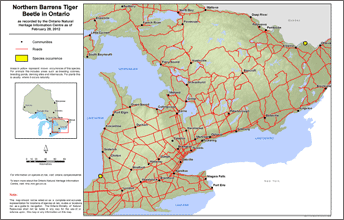Northern barrens tiger beetle
Scientific name: Cicindela patruela

Cover photo credit: Michael Runtz
Status
Endangered
“Endangered” means the species lives in the wild in Ontario but is facing imminent extinction or extirpation.
Date added to the Species at Risk in Ontario List
March 18, 2010
Read the Assessment Report
What it looks like
The Northern barrens tiger beetle was formerly referred to as the Patterned green tiger beetle. It is a relatively small (12 to 14.5 millimetres in length) ground beetle.
Like all tiger beetles, it has conspicuously large eyes, large sickle-shaped mandibles and long legs. It is dull metallic green in colour with distinct cream-coloured markings on its otherwise green wing covers.
The Northern barrens tiger beetle has a two year life cycle. In Ontario, adults emerge from subterranean hibernation sites in late May, mate and lay eggs in June, and then die by early to mid July. Eggs hatch in mid July and the larvae remain in burrows for a year before transforming to pupa and then emerging as newly transformed adults in fall.
The ‘grub-like’ tiger beetle larvae are light-coloured with a brown head capsule and a large set of mandibles. They are highly predaceous, ambushing small invertebrates that come within reach of the burrow entrance.
Where it lives
The Northern barrens tiger beetle occurs in natural or other openings in sandy oak-pine woodlands and savannah.
It prefers areas with sparse understorey vegetation over coarse-grained sand deposits.
As such, it is dependent on periodic disturbances (e.g., fire) for the maintenance of its open habitat. Canadian populations of the Northern barrens tiger beetle have been found in mature vegetated dunes and along trails.
Where it’s been found in Ontario
The Northern barrens tiger beetle is a globally restricted, rare species found in only 30 sites in its north-central and eastern North America range, which extends as far north as southern Ontario.
Although this tiger beetle has historically been recorded at three locations in Canada (two in Ontario and one in Quebec), it is currently only known to occur at a single site along the southeast shore of Lake Huron.
View a Larger version of this map (PDF)
What threatens it
Development, deforestation, human recreational activities, and fire suppression has occurred throughout most of the Northern barrens tiger beetle’s range.
It is thought that these human impacts are the primary factor causing the tiger beetle’s decline.
Action we are taking
Endangered Species and their general habitat are automatically protected.
Recovery strategy
A recovery strategy advises the ministry on ways to ensure healthy numbers of the species return to Ontario.
Read the executive summary (February 18, 2011)
Read the recovery strategy (February 18, 2011)
Government response statement
A government response statement outlines the actions the government intends to take or support to help recover the species.
Read the government response statement (November 18, 2011)
Five-Year Review of Progress
A five-year review reports on progress made toward protecting and recovering a species, within five years of publishing a species’ government response statement.
Read the report on progress towards the protection and recovery of 27 species at risk, including Northern Barrens Tiger Beetle (2016).
Habitat protection
A habitat regulation defines a species' habitat and many describe features (e.g., a creek, cliff, or beach), geographic boundaries or other unique characteristics.
Read the habitat summary (July 1, 2012)
What you can do
Report a sighting
The Ministry of Natural Resources and Forestry tracks species at risk such as the Northern barrens tiger beetle. Report a sighting of an endangered animal or plant to the Natural Heritage Information Centre. Photographs with specific locations or mapping coordinates are always helpful.
Volunteer
Volunteer with your local nature club or provincial park to participate in surveys or stewardship work focused on species at risk.
Be a good steward
- private land owners have a very important role to play in species recovery; if you find Northern barrens tiger beetle on your land, you may be eligible for stewardship programs that support the protection and recovery of species at risk and their habitats
- as with many other rare plants and animals, the Northern barrens tiger beetle is at risk due to the loss of its specific sandy oak-pine woodland and savannah habitat; you can help by protecting natural vegetation on your property
Report illegal activity
Report any illegal activity related to plants and wildlife to
Quick facts
- Northern barrens tiger beetles are ambush predators; they mostly eat ants, but feed on a diversity of small insects
- the Bee fly (Anthrax georgicus) is a parasite of tiger beetles and has contributed to the decline of some populations of Northern barrens tiger beetle
- females lay about 50 eggs during early summer; each egg is placed in an individual hole in the ground ranging in depth from 3 to 5 millimetres
- Northern barrens tiger beetles control their body temperature through their behaviour (e.g., basking in the sun or moving into the shade); they are most active on clear summer days when their internal temperature reaches 34°C
